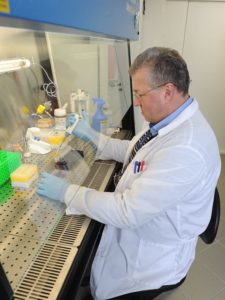The Brief history of the laboratory
The Laboratory of General Virology was established in 1987. The team’s research aimed at studying the effectiveness of a live influenza vaccine and putting it into public health practice. Moreover, special attention paid to the development of an influenza B master donor virus and to the production conditions of the trivalent live influenza vaccine. One of the directions of the laboratory’s work was the creation of a multivalent live influenza vaccine both for adults and children. It was registered in 2003.
The Main areas of research
The main area of research is developing of potentially pandemic live influenza vaccines of types A (H2N2), A (H7N3), A (H1N1), A (H5N1), A (H7N9) and testing of clinical trials of new vaccine preparations. Furthermore, new directions develop for combined viral-bacterial intranasal immunization based on live influenza vaccine and recombinant bacterial polypeptides. There is range of researches justifying the use of cold-adapted influenza viruses as a platform for constructing vector vaccines against viral diseases and viral and bacterial infections.
The Main Scientific Results over the past 5 years
Preclinical and clinical trials of potentially pandemic live influenza vaccines of types A(H2N2), A(H5N2), A(H7N3), A(H7N9) were performed. Safety, genetic stability and absence of transmission were shown in this research. A national collection of these vaccine strains had been created. Thus, it is possible now in the event of pandemic to begin quick production of influenza vaccines on the base of these strains for mass immunization of the population.

Leading researcher Rekstin A.R. is working in the Biosafety Cabinet.
It is necessary to develop not only pandemic vaccines, in connection with the preparation for a future influenza pandemic, but also a rational strategy for their use. In this case, it is important to take into account the time and the volume of production, allowing in a short time to vaccinate the maximum number of people. For that purpose, the laboratory conducted clinical trials of a new prevention strategy, involving the usage of live influenza vaccine of type A (H5N2) as a priming drug and inactivated vaccine of type A (H5N1) as boosting with an interval of 18 months. Vaccination of inactivated influenza vaccine with unpriming individuals weakly stimulated a humoral immune response to a homologous strain. The priming volunteers with a live influenza vaccine hardly accelerated and enhanced the production of serum antibodies. This effect indicates the ability of a live influenza vaccine to induce long-term B-cell immunological memory both to a specific virus and to heterologous antigens of avian influenza viruses. Epitopes of the respiratory syncytial virus (RSV), which is the main risk factor for children under the age of 1 year and the elderly, were established and analyzed, as part of the development of recombinant vector vaccines. The most promising of them for the further construction of vector vaccines were selected. Chimeric influenza viruses constructed on the base of the obtained data, carrying epitopes of the respiratory syncytial virus, are immunogenic and have a protective effect against wild-type influenza virus after double vaccination of BALB / c mice. It is shown that the insertion of antigens of the respiratory syncytial virus into the vaccine strain of the live influenza vaccine did not affect its protective attributes against the homologous influenza virus. In addition, the laboratory designed the first chimeric virus-bacterial constructs for combined immunization against influenza and against bacterial infections caused by group B streptococci and pneumococci. These vaccines are able to induce a humoral immune response in experimental animals to both the viral vector and the integrated bacterial protein.
